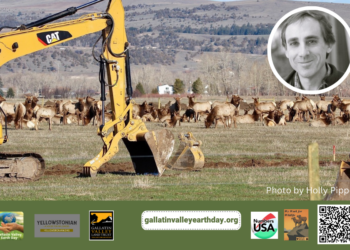Critical habitat proposal reduces areas around Yellowstone but adds acreage in Colorado, New Mexico
By Benjamin Alva Polley EBS COLUMNIST
During my first winter in Montana, I volunteered for a noninvasive rare carnivore study in the North Fork of the Flathead River, which included land within Glacier National Park and the Whitefish Range. Our crew consisted of two members, while another crew based in West Glacier conducted tracking surveys in the Middle Fork region. We studied fishers, lynx and wolverines.
The study took place during the winter of 2003-04. Whenever we found tracks of these small to medium-sized mammals, we would backtrack to search for hair samples from beds, kill sites and scat, or we would set up remote cameras. Our methods included cross-country skiing, snowshoeing, or using snowmobiles (when permitted) to access the backcountry and look for signs of the animals.
We found tracks and scat from Canada lynx and wolverines that winter, but we did not detect any signs of fishers. The study’s primary objective was to determine whether any of these mid-sized carnivores had a breeding population in the area.
All three species were nearly trapped to extinction in the early to mid-1900s, and their populations continue to be precarious in the contiguous United States. While the populations of wolverines and lynx are relatively healthier than those of fishers, all three species require human assistance for their populations to recover, especially until numbers get high enough. Wolverines are the most prominent members of the weasel family, while fishers are smaller than wolverines but larger than pine martens. Canada lynx are medium-sized felines that resemble bobcats but have short, bobbed tails, longer legs and more enormous paws, measuring about 4 inches by 4 inches. These adaptations allow them to move on snow and hunt snowshoe hares. Lynx have long ear tufts, a grizzled gray appearance, weigh between 15 and 38 pounds, and measure about 33 inches in length. They are listed as a threatened species under the Endangered Species Act.
At the end of November, the U.S. Fish and Wildlife Service finalized a recovery plan for the Canada lynx, proposing new critical habitat designations to enhance federal protections for this elusive “shadow of the forest.” Lynx populations thrive in Alaska and Canada but struggle in the contiguous U.S. Lynx prefer to live in boreal forests, which have deep snow with a lot of tree cover, and they hunt in open meadows.
The USFWS proposes revisions to the current habitat designation plan to support the population’s long-term survival. The proposed plan covers approximately 19,000 square miles across Colorado, Idaho, Montana, New Mexico, Washington and Wyoming. This revision is based on the latest science regarding habitat needs but does not address the requirements of lynx populations in Minnesota or Maine. A large area around the Greater Yellowstone Ecosystem, including portions of the national park and Montana’s Gallatin, Carbon, Park, Stillwater and Sweetgrass counties, has been removed from the proposal. However, the revised critical habitat designations would add protections to over 7,500 square miles in Colorado and New Mexico.
It’s great that the USFWS is proposing a new critical habitat for lynx based on science, but shouldn’t the area include habitat between the northern and southern populations for genetic exchange and resiliency?
The federal government defines critical habitat as being essential for the survival and recovery of species protected under the Endangered Species Act. In 2000, Canada lynx were listed as “threatened” under the act. Their numbers fluctuate in cycles based on the populations of snowshoe hares, their primary prey.
The USFWS decided to remove a large swath of land around the Greater Yellowstone Ecosystem because a breeding population has not existed, and no lynx have been observed in this area for over a decade.
Habitat in the southern Rockies has been expanded because lynx populations are thriving due to a reintroduction effort that began at the turn of the century.
In all my years in the backcountry working on wildlife studies, backcountry trail crews, hiking and hunting, I have yet to see a fisher or lynx.
In an age where the human population continues to surge, wildlife habitats shrink and become fragmented by development. Canada lynx and other species—whether listed under the Endangered Species Act or not—require human assistance. They cannot recover on their own.
Benjamin Alva Polley is a place-based storyteller. His stories have been published in Audubon, Esquire, Field & Stream, The Guardian, Outside, Popular Science, Sierra, and other publications on his website. He holds a master’s in Environmental Science and Natural Resource Journalism from the University of Montana.













